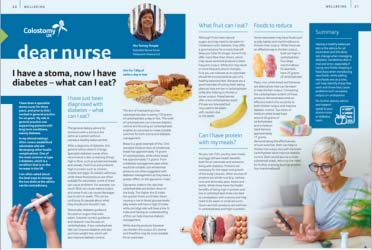 Tammy Temple is a Stoma Nurse with a background in care for patients with type 2 diabetes. Here, she answers questions on how best to manage diabetes and living with a stoma.
Tammy Temple is a Stoma Nurse with a background in care for patients with type 2 diabetes. Here, she answers questions on how best to manage diabetes and living with a stoma.
Can you provide any information on the rate of diabetes amongst ostomates?
No specific incidence of diabetes and ostomates but as you know diabetes is increasing in the general population.
Is it mainly Type 1 or Type 2 diabetes?
Type 1 and 2 are very different so the information is related to type 2 as this is treated with diet and also medication.
Why are patients with an ileostomy the group that concerns you most?
Ileostomates are the group I wanted to focus on as they can have watery output and are given dietary advice on foods that can thicken the output. Often this information is foods such as jelly babies and marshmallows which will increase blood glucose levels when white starch, such as white bread, potatoes and pasta can be just as effective. Bananas are also a good option to thicken output.

What are the biggest challenges they face?
The biggest challenges are that the dietary advice does not always consider both conditions, and when a patient sees a dietician they can end up feeling confused because the advice may have been contradictory – advice such as white carbs, jelly babies and starchy foods, and foods without a skin and reduced salads and vegetables for an ileostomy. But with diabetes it needs to be increased fruit and veg, and whole meal products.

What’s the current advice for ostomates on thickening output?
Current advice for thickening the output regarding diet is white starchy foods such as white bread, pasta, crackers, bananas. Also marshmallows and jelly babies and an oral medication called Loperamide can be used.
Why this isn’t suitable for ostomates who are diabetic?
Use of jelly babies and marshmallows will increase blood glucose levels which is not ideal if you have type 2 diabetes.

What can you recommend as alternatives?
Alternatives would be white carbs; crackers are a good option and also bagels can thicken output. Patients with diabetes will be advised to eat wholemeal products. These break down the glucose at a slower rate which can stabilise blood glucose levels, but can also increase risk of a blockage or watery output which can cause leaks.
Why is this better, what about the sugars in fruit, is this also risky?
The natural sugars found in fruit can be a risk with diabetes and the advise is often berries such as strawberries, blueberries and raspberries as these have less natural sugars – although they can increase watery output and the risk of a blockage due to skins and seeds.
Is there any guidance on portion size?
There’s no specific guidance on portion sizes, but a healthy balanced diet is advised. Patients are advised to have a low residue diet initially following surgery while the bowel recovers then gradually introduce other items.
Any other advice or signposting to find out more?
A good resource if you have been diagnosed with type 2 diabetes is a book called Carbs and Cals, which is a pictorial book with portion sizes and the amount of carbohydrates per item – very valuable in diabetic clinics!

If you’d like to hear more from Tammy, she wrote an article for Colostomy UK’s Tidings magazine. Read the article here, page 20.

If you’d like to hear from a dietitian who regularly works with stoma patients to manage diabetes, Laura Coster wrote a blog for us about how to find a balanced diet to manage both conditions: Balancing Blood Sugar and Gut Health: Diabetes and Stoma-Friendly Eating
